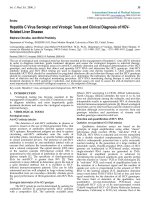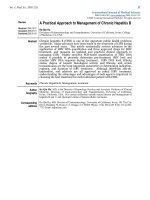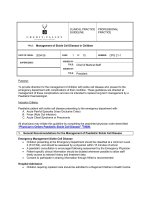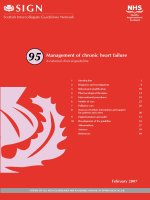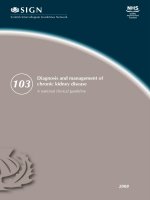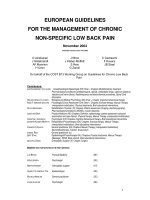Management of Complications of Chronic Liver Disease: “When to Refer to Transplant?” docx
Bạn đang xem bản rút gọn của tài liệu. Xem và tải ngay bản đầy đủ của tài liệu tại đây (22.39 MB, 59 trang )
Management of Complications
of Chronic Liver Disease:
“When to Refer to Transplant?”
Philip Rosenthal, M.D.
Professor of Pediatrics & Surgery
University of California,
San Francisco
THE LIVER
• Largest organ in body
• RUQ of abdomen
• Sheltered by rib cage
• In adult, weighs 3 lbs.
LIVER: GROSS ANATOMY
• Separated into 2 lobes:
Right and Left
• Right lobe is ~6X
larger than the left
• Porta hepatis is entry
site for blood vessels
and exit site for bile
ducts
Liver Transplantation
• Anatomical segments
• Living-related
• Split
• Reduced-sized
Split liver
HEPATIC CIRCULATION
• A dual blood supply
• Portal vein drains
intestines and spleen-
provides 75% of
liver’s blood supply
• Hepatic artery supplies
oxygenated blood
from aorta-provides
25% of blood supply
CELLULAR ARCHITECTURE
• Portal vein and hepatic
artery branch within
the lobes to form
sinusoids that run
parallel to rows of
hepatocytes (liver
cells)
• Sinusoids allow
exchange of
substances to liver
cells
CELLULAR ARCHITECTURE
• Hepatocytes are most
abundant and
metabolically active
• Kupffer cells in the
sinusoids are
scavenger cells for
foreign matter, worn-
out blood cells and
bacteria
CELLULAR ARCHITECTURE
• The liver is organized
into polyhedral units-
lobules
• On cut section, a
lobule is hexagonal
with 6 portal triads at
the periphery
• Portal triad-branch of
hepatic artery, portal
vein, bile duct
REGENERATIVE ABILITY
• Hepatocytes rarely divide but have the
capacity to reproduce in response to
appropriate stimuli
• This process can restore the liver to within
5-10% of its original weight
• Liver regeneration plays an important role
after surgical resection or after injury that
destroys portions of the liver
LIVER FUNCTIONS
• Purification,
transformation and
clearance of:
– ammonia
– bilirubin
– hormones
– drugs
– toxins
LIVER FUNCTIONS
• Regulation of:
– glucose
– cholesterol
• Storage of:
– glucose
– fat-soluble vitamins
– folate
– vitamin B12
– copper
– iron
LIVER FUNCTIONS
• Synthesis and
secretion of:
– albumin
– clotting factors
– transporter proteins
– cholesterol
– bile
– glucose
– complement
Hepatic Disorders
• Metabolic disorders
– Glycogen storage
– Urea cycle OTC, CPS
– Alpha 1 antitrypsin
– Wilson's
• Cholestatic
– Biliary atresia
– Alagille syndrome
– PFIC (Bylers)
• Hepatitis
– A,B,C
– Neonatal
autoimmune
• Hepatoblastoma/HCC
• FHF
• Cystic
(combined KLTx)
• other
Metabolic Diseases
Metabolic Diseases
• Tyrosinemia
– NTBC therapy effective in most
– Transplant indicated for adenoma/carcinoma
formation
• Crigler-Najjar
• Urea cycle defects
• Fatty acid oxidation defects
• Glycogen storage disease
PROGNOSIS
PROGNOSIS
Recognizing High Risk Patients
Recognizing High Risk Patients
• Acute Liver Failure
• Age less than 3 months
• Advanced malnutrition
• Recurrent infections
• Multi-organ system disease
MEDICAL MANAGEMENT OF
MEDICAL MANAGEMENT OF
LIVER TRANSPLANT
LIVER TRANSPLANT
CANDIDATES
CANDIDATES
• Management of complicated portal
hypertension
• Nutritional support
• Aggressive management of
infection
• Appropriate immunizations
Treatment Options
• Supportive
• Nutrition
• Vitamins
• Antipruritics
• Ursodeoxycholic Acid
• Transplantation
General Principles
• With cholestasis, fat-soluble vitamins and
medium chain triglycerides are usually
required to optimize growth
• Children who are anicteric but who have
cirrhosis present a different challenge since
hypermetabolism, enteropathy, and
increased protein oxidation may occur
General Principles
• Various inborn errors of metabolism that cause
liver disease (i.e. galactosemia, tyrosinemia,
hereditary fructose intolerance, Wilson disease)
have specific nutritional requirements and dietary
restrictions
• The success of pediatric liver transplantation has
made the recognition of the importance of
nutritional support in the pretransplant period
imperative to optimize the success of the
transplant
Nutritional Assessment of the Child
with Liver Disease
• A nutritional assessment is needed to
determine the degree of malnutrition if
present and to tailor the nutritional
intervention
• The severity of malnutrition may not
correlate with the degree of vitamin or
trace mineral deficiency or the degree
of hepatic dysfunction
Nutritional Assessment of the Child
with Liver Disease
• A number of obstacles complicate the ability to
accurately assess the nutritional status of a child
with liver disease
– Body weight may be deceptive because
organomegaly from an enlarged liver or spleen,
edema or ascites can mask weight loss and
actually increase or falsely inflate the weight
– Height is a better indicator of malnutrition in
these children and can be a reliable tool to
determine chronic malnutrition
– A decrease in height for age percentile may be
indicative of the duration of malnutrition
Nutritional Assessment of the Child
with Liver Disease
• Triceps skinfold and arm circumference
measurements provide a sensitive indicator
of nutritional status in children with chronic
liver disease
• Lower extremities are more prone to
peripheral edema and fluid retention than
upper extremities
• Upper extremity measurements may be a
better indicator of body fat stores and
muscle mass
Nutritional Assessment of the Child
with Liver Disease
• Reduced fat fold thickness and mid upper
arm circumference have been observed in
children prior to weight or height reductions
• In children, early reduction in fat and
muscle stores reflects the preferential
utilization of fat stores to conserve protein
stores for energy in the malnourished state
• To optimize the accuracy of
anthropometric measurements,
it is best to
utilize a single observer using a standard
technique with serial measurements
Nutritional Assessment of the Child
with Liver Disease
• Measurement of plasma proteins including
albumin, transferrin, prealbumin, and
retinol-binding protein that are synthesized
by the liver has been used to determine
visceral protein nutriture
• Diminished serum levels of these proteins
may not accurately reflect the body’s
visceral protein status
• The serum concentrations of these proteins
more closely relate with the severity of liver
injury as opposed to the degree of
malnutrition as assessed by anthropometric
measurements
Nutritional Assessment of the Child
with Liver Disease
• Hypoalbuminemia in chronic liver
disease patients often results due to
third spacing of fluid and protein in
ascites or the extravascular
compartment
• There is often increased catabolism of
albumin without a compensatory
increase in albumin synthesis, due to
inadequate reserves and malabsorption
of amino acids and peptides
